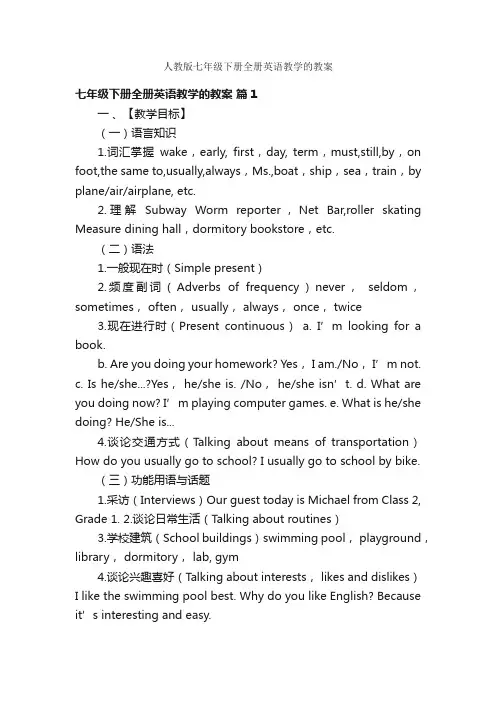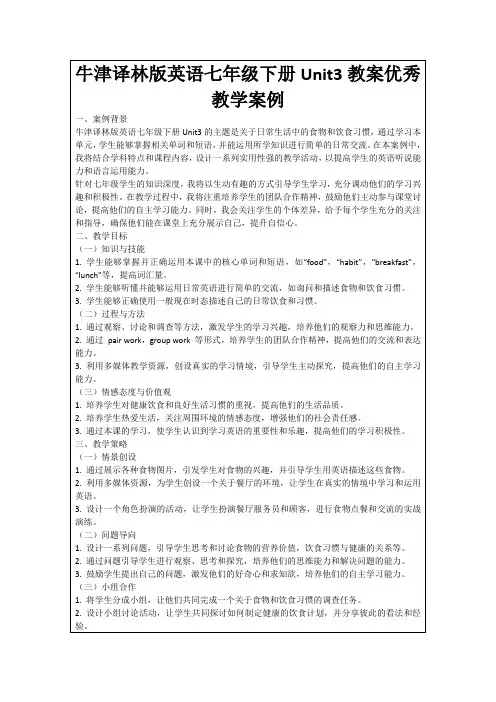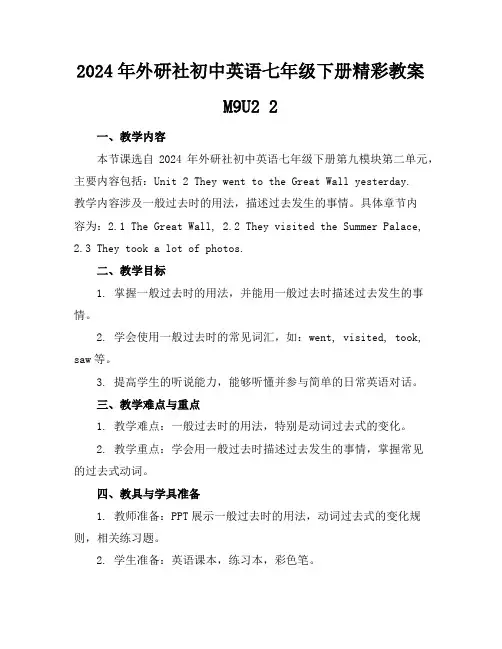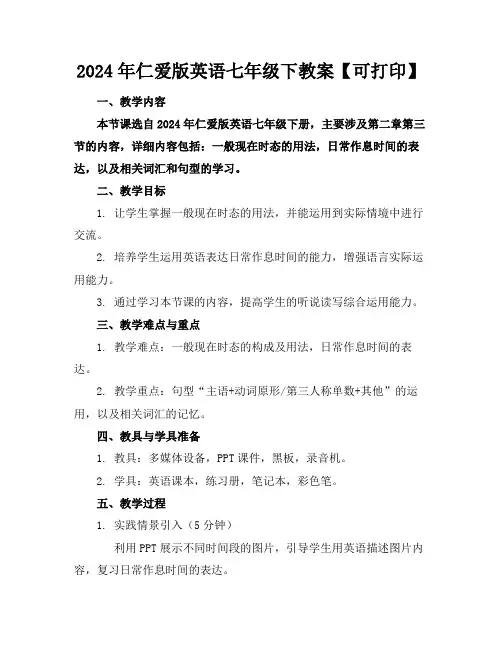初中英语初一下册教案
人教版七年级下册全册英语教学的教案

人教版七年级下册全册英语教学的教案七年级下册全册英语教学的教案篇1一、【教学目标】(一)语言知识1.词汇掌握wake,early, first,day, term,must,still,by,on foot,the same to,usually,always,Ms.,boat,ship,sea,train,by plane/air/airplane, etc.2.理解Subway Worm reporter,Net Bar,roller skating Measure dining hall,dormitory bookstore,etc.(二)语法1.一般现在时(Simple present)2.频度副词(Adverbs of frequency)never,seldom,sometimes, often, usually, always, once, twice3.现在进行时(Present continuous)a. I’m loo king for a book.b. Are you doing your homework? Yes, I am./No,I’m not.c. Is he/she...?Yes, he/she is. /No,he/she isn’t.d. What are you doing now? I’m playing computer games.e. What is he/she doing? He/She is...4.谈论交通方式(T alking about means of transportation)How do you usually go to school? I usually go to school by bike.(三)功能用语与话题1.采访(Interviews)Our guest today is Michael from Class 2, Grade 1.2.谈论日常生活(Talking about routines)3.学校建筑(School buildings)swimming pool, playground,library, dormitory, lab, gym4.谈论兴趣喜好(Talking about interests, likes and dislikes)I like the swimming pool best. Why do you like English? Because it’s interesting and easy.5.借物(Borrowing things)How long can I keep it? Two weeks.6.新闻(News)、海报(Poster)Attention,please! Here is the news.7.谈论学校活动、科目和时间表(Talking about school activities,subjects and timetable)8.谈论学校生活(Talking about school life)(四)能力培养【听】能听懂谈论校园生活中比较熟悉的话题,识别主题,获取主要信息。
七年级英语外研版下册教案通用5篇

七年级英语外研版下册教案通用5篇七年级英语外研版下册教案通用5篇英语教师研制一份教案,是为了加强课堂教学的目的性和计划性。
下面是小编为你准备的七年级英语外研版下册教案,快来借鉴一下并自己写一篇与我们分享吧!七年级英语外研版下册教案篇1一、指导思想在本学期的英语教学中,坚持《英语课程标准》中以下教学理念,面向全体学生,关注每个学生的情感,激发他们学习英语的兴趣,帮助他们建立学习的成就感和自信心,让学生在老师的指导下通过感知、体验、实践、参与和合作等方式,实现任务的目标,感受成功;注重过程评价,促进学生发展,建立能激励学生学习兴趣和自主学习能力发展的评价体系。
总之,让学生在使用英语中学习英语,让学生成为使用者而不仅仅是学习者。
让英语成为学生学习生活中最实用的工具而非累赘,让他们在使用和学习英语的过程中,体味到轻松和成功的快乐,而不是无尽的担忧和恐惧。
二、教材分析这套教材采用任务型语言教学模式,融汇话题、交际功能和语言结构,形成了一套循序渐进的生活化的学习程序。
与原教材相比还增加了文化背景和学习策略等部分,并增加了任务型学习成份和语篇的输入。
本书每个模块都列出明确的语言目标、主要的功能项目与语法结构、需要掌握的基本词汇,并分为三个单元。
Unit1部分是基本对话内容,Unit2部分是短文,主要是阅读训练。
Unit3是扩展和综合的语言运用。
三、学生基本情况分析我所任教的是七年级1、2班英语,只有少部分学生的英语基础较好,取得了一定的成绩,大多数学生不能明确学习英语的目的,没有真正认识到学习英语的目的在于交流;没有养成良好的.学习习惯,不能做好课前预习课后复习,不善于发现和总结语言规律,不注意知识的巩固和积累。
四、具体措施1、每天背诵课文中的重点对话。
目的:要求学生背诵并默写英语句子,培养学生良好的英语语感。
2、每天听写本节课中需要用到的重点生词,常用句子或习语。
利用“互测及教师抽查”及时检查,保证效果并坚持下去。
牛津译林版英语七年级下册Unit3教案优秀教学案例

4.反思与评价:在课堂的最后阶段,我引导学生进行自我反思,思考自己在课堂上的学习收获和需要改进的地方。这个环节让学生更加关注自己的学习过程,有助于他们提高学习效果。
10.教学语言人性化:在整个教学过程中,我使用了人性化的语言,与学生建立了良好的互动关系。这有助于营造一个轻松愉快的学习氛围,提高学生的学习兴趣。
1.通过观察、讨论和调查等方法,激发学生的学习兴趣,培养他们的观察力和思维能力。
2.通过pair work,group work等形式,培养学生的团队合作精神,提高他们的交流和表达能力。
3.利用多媒体教学资源,创设真实的学习情境,引导学生主动探究,提高他们的自主学习能力。
(三)情感态度与价值观
1.培养学生对健康饮食和良好生活习惯的重视,提高他们的生活品质。
3.设计一个角色扮演的活动,让学生扮演餐厅服务员和顾客,进行食物点餐和交流的实战演练。
(二)问题导向
1.设计一系列问题,引导学生思考和讨论食物的营养价值,饮食习惯与健康的关系等。
2.通过问题引导学生进行观察、思考和探究,培养他们的思维能力和解决问题的能力。
3.鼓励学生提出自己的问题,激发他们的好奇心和求知欲,培养他们的自主学习能力。
3.引入本课的主题:“今天我们将会学习关于食物和饮食习惯的英语表达。”
(二)讲授新知
1.教授本课的核心单词和短语,如“food”,“habit”,“breakfast”,“lunch”等,并让学生进行反复练习。
2.通过例句和情景展示,教授一般现在时态的用法,并让学生进行句子练习。
2024年外研社初中英语七年级下册精彩教案M9U22

2024年外研社初中英语七年级下册精彩教案M9U2 2一、教学内容本节课选自2024年外研社初中英语七年级下册第九模块第二单元,主要内容包括:Unit 2 They went to the Great Wall yesterday.教学内容涉及一般过去时的用法,描述过去发生的事情。
具体章节内容为:2.1 The Great Wall, 2.2 They visited the Summer Palace,2.3 They took a lot of photos.二、教学目标1. 掌握一般过去时的用法,并能用一般过去时描述过去发生的事情。
2. 学会使用一般过去时的常见词汇,如:went, visited, took, saw等。
3. 提高学生的听说能力,能够听懂并参与简单的日常英语对话。
三、教学难点与重点1. 教学难点:一般过去时的用法,特别是动词过去式的变化。
2. 教学重点:学会用一般过去时描述过去发生的事情,掌握常见的过去式动词。
四、教具与学具准备1. 教师准备:PPT展示一般过去时的用法,动词过去式的变化规则,相关练习题。
2. 学生准备:英语课本,练习本,彩色笔。
五、教学过程1. 导入:通过展示一组图片,让学生猜测图片中的人物昨天去了哪里,引出一般过去时。
2. 新课内容呈现:讲解一般过去时的用法,展示动词过去式的变化规则。
3. 例题讲解:解析一般过去时的句子结构,给出例句并进行讲解。
4. 随堂练习:让学生根据所学内容,完成一般过去时的练习题。
5. 小组活动:学生分成小组,用一般过去时描述昨天去过的地方或做过的事情。
六、板书设计1. 一般过去时的句子结构:主语 + 动词过去式 + 其他2. 常见动词过去式:go wentvisit visitedtake tooksee saw七、作业设计1. 作业题目:(1) 根据下列句子,用一般过去时完成句子:a. We _______ to the zoo last week.b. She _______ her grandparents yesterday.(2) 写一段话,描述你昨天做过的事情。
七年级下册英语课教案(优秀5篇)

七年级下册英语课教案(优秀5篇)(经典版)编制人:__________________审核人:__________________审批人:__________________编制单位:__________________编制时间:____年____月____日序言下载提示:该文档是本店铺精心编制而成的,希望大家下载后,能够帮助大家解决实际问题。
文档下载后可定制修改,请根据实际需要进行调整和使用,谢谢!并且,本店铺为大家提供各种类型的经典范文,如合同协议、条据文书、策划方案、总结报告、党团资料、读书笔记、读后感、作文大全、教案资料、其他范文等等,想了解不同范文格式和写法,敬请关注!Download tips: This document is carefully compiled by this editor. I hope that after you download it, it can help you solve practical problems. The document can be customized and modified after downloading, please adjust and use it according to actual needs, thank you!Moreover, our store provides various types of classic sample essays, such as contract agreements, documentary evidence, planning plans, summary reports, party and youth organization materials, reading notes, post reading reflections, essay encyclopedias, lesson plan materials, other sample essays, etc. If you want to learn about different formats and writing methods of sample essays, please stay tuned!七年级下册英语课教案(优秀5篇)教案是备课的展示与体现,至于采取何种形式还得根据教师实际而定。
2024年仁爱版英语七年级下教案【可下载打印】

2024年仁爱版英语七年级下教案【可打印】一、教学内容本节课选自2024年仁爱版英语七年级下册,主要涉及第二章第三节的内容,详细内容包括:一般现在时态的用法,日常作息时间的表达,以及相关词汇和句型的学习。
二、教学目标1. 让学生掌握一般现在时态的用法,并能运用到实际情境中进行交流。
2. 培养学生运用英语表达日常作息时间的能力,增强语言实际运用能力。
3. 通过学习本节课的内容,提高学生的听说读写综合运用能力。
三、教学难点与重点1. 教学难点:一般现在时态的构成及用法,日常作息时间的表达。
2. 教学重点:句型“主语+动词原形/第三人称单数+其他”的运用,以及相关词汇的记忆。
四、教具与学具准备1. 教具:多媒体设备,PPT课件,黑板,录音机。
2. 学具:英语课本,练习册,笔记本,彩色笔。
五、教学过程1. 实践情景引入(5分钟)利用PPT展示不同时间段的图片,引导学生用英语描述图片内容,复习日常作息时间的表达。
2. 例题讲解(10分钟)讲解一般现在时态的用法,通过例句展示,让学生理解和掌握该时态的构成及用法。
3. 随堂练习(15分钟)课堂互动,让学生分组进行对话练习,用一般现在时态描述日常作息时间。
4. 巩固环节(10分钟)利用练习册上的题目,让学生独立完成,巩固所学知识。
5. 课堂小结(5分钟)6. 互动环节(10分钟)学生上台展示,用英语分享自己的日常作息时间。
7. 作业布置(5分钟)布置课后作业,强调作业要求和完成时间。
六、板书设计1. 一般现在时态的构成及用法2. 日常作息时间的表达3. 相关词汇和句型七、作业设计1. 作业题目:(1)用一般现在时态写一段话,描述你的日常作息时间。
(2)根据所给词汇,完成下列句子。
2. 答案:(1)I usually get up at 6:30 in the morning. After breakfast, I go to school at 7:30. I have lunch at 12:00 noon.In the afternoon, I get back home at 5:00. I do my homework and have dinner at 7:00. Finally, I go to bed at 9:30.(2)e.g. I often watch TV in the evening.八、课后反思及拓展延伸1. 课后反思:关注学生在课堂上的表现,针对学生的掌握情况,调整教学方法,提高教学效果。
人教版初中英语七年级下册全册英教案(全英文版)
新目标人教版英语七下全册教案(全英文版)Unit 1 Wheres your pen pal from?Language goals:•In this unit students learn to talk about countries, nationalities and Ian guages.•Ask and tell where people live.New languages:•Where's he / she from?•He / She is from Australia / England / China / France / Singapore / Australia. •Where does he / she live? He / She lives in Sydney.•What language do you speak? I speak English.•What's your / his / her favorite subject?•My / His / Her favorite subject is English.•Does he / she have any brothers and sisters? Yes, he/ she does. / No, he / she doesn't.Difficult points:1. Liste ning for the in formation about cou ntries, natio nalities and Ian guages. Write an e-mail about on eself. Describe the new stude nts in class.2. Where questions with fromWhere questions with liveWhat questi onsTeaching aids:• A tape recorderTeaching periods:•Period 1:Section A 中1a, 1b, 1c•Period 2:Section A 中2a, 2b, 2c, 2d•Period 3:Section A 中3a, 3b, 4•Period 4:Section B 中1,2a, 2b, 2c•Period 5:Section B 中3a, 3b, 3c, 4•Period 6:Self CheckPeriod 1Teaching aims:1. Teach vocabulary words.2. Target Ianguages:Where's your pen pal from?He is from Australia.3. Enable the students to learn to talk about nationalities.4. Help the students learn how to talk about nationalities.Teaching procedures:Step 1. Free talk2 Say: Do you have any friends? Where is she from?Help the students make the same sentences and give them more chances to say.Step 2. Talking about the picture (1a)Hold up the picture on page 1 and point at the map. Ask students toread the picture.Ask some of you to read them aloud to the class. Make the studentstalk about where people are from.Say: Du Chuan, where is your pen pal from?Ask the students to read the conversations in the picture.Step 3. Listening (1b)Point to the numbered list of words and play the recording for a secondtime.Ask the students to listen to the recording and circle the countries in 1a.Ask students to listen to and repeat after the recording and then checkthe answers.Step 4. Pair work(1c)1. Now work in pairs and read the conversations in 1a with your partner.You can talk about your own pen pal.2. Ask the students to look at their own clothes and the things in theirbackpack. Ask and answer questions about where they are from.Homework1. Ask the students to practice talking about where people are from and make up real dialogues.2. Learn the words in this unit (on page 115) by heart.Period 2Teaching aims:1. Learn the vocabulary words and useful expressions.2. Target languages: Where does he live? He lives in Toronto.3. Let the students learn to talk about where people live.4. Help the students learn how to talk about where people live.Teaching procedures:Step I.StepI RevisionCheck the homework. And then ask several students to answer questi ons.Say: Where are you from? Do you have a pen pal? Where is your pen pal from?Step 2. Presentation (2a)Put a map of the world on the blackboard.Say: What's the meaning of capital? Can you guess? Help them to answer.Write Australia, the United States, Canada, France, and Japan on theleft of the blackboard. And write Sydney, New York, Paris, Toronto, andTokyo on the right of the blackboard. And the teacher reads them aloudand asks students to repeat.Then ask students to match the cities with the countries.Step 3. Talk about countries and citiesAsk the students to work in pairs, asking about the cities and the countries.Say: Now work in pairs and ask where the city is. For example, the firststudent asks "Where is Beijing?” the second student answers “It's inChina."Then tell the students to ask question about Chinese cities.Step 4. Listening (2b, 2c)Tell the students to read the list of countries and cities in 2a.Say: Now let's look at the list of countries and cities in Activity 2a. I will ask some students to read them aloud to the class.Call the students' attention to the chart in 2c.Tell the students to listen to the conversations in Step 4 again to complete the chart.Step 5. Pair work(2d)Ask the students to read the conversations in the bubble. Then askthem to talk about the in formation in the chart in 2c.Then ask the students to work in groups and make up new dialogueswith their own information.Step 6.GrammarfocusReview the grammar box.Say: You have to pay attention the word "from". It always follows verb be, while live comes out alone in where sentences. Now make more sentences with where, from and live.Write the following on the blackboard.Say, now work in pairs and make dialogues after the model above.Homework1. Ask the stude nts to learn the sentence patter ns in Grammar Focus by heart. Try to use them freely.2. Remember the words in this unit (on page 115).3. Make a similar dialogue according to the conversation in 2d.Period 3Teaching aims:1. Teach vocabulary words.2. Target Ianguages: What Ianguage does she speak? She speaks English.3. Enable the students to learn to talk about what Ianguage people speak.4. Help the students to learn how to talk about what language people speak.Step 1. Free talkSay, Morning, boys and girls. Nice to see you again. Do you remember we have learned about how to ask where people are from and how to ask where people live? Now I want some of you to answer my questi ons.(Turn to a student.)Where are you from?Give more students chances to speak in class.Step 2. Presentation (3a)Say: Do you know the meaning of "Ianguage"? Listen: Tim is from England and he speaks English. So English is his Ianguage. I'm fromChina, so Chinese is my language .Now look at activity 3a.on page 3.Read the instructions to the class. Ask students to work in pairs as theyanswer the questions.Show the flowing and ask the students to make conversations after themodel.Step 3. Pair work (3b)Ask the students to pay attention to the conversation in Activity 3b.Say, Read the dialogue by yourselves. Then I will ask some pairs to act out the dialogue in class.Show a map of the world. Ask students to work in pairs.Step 4. Quiz(4)Ask the students to look at activity 4 then work in pairs and do the quiz.HomeworkAsk the students to work with their friends and practice the dialogue in activity 3b.Period 4Teaching aims1. Teach vocabulary words.2. Target languages:Does she have any brothers and sisters?Is that your new pen pal?Yes, it is.3. Enable the students to learn to talk about their new pen pals.4. Help the students learn how to talk about their new pen pals.Step 1. RevisionAsk the students to make conversations talking about their new pen pal.Ask some pairs to the front to talk about their pen pals. Greet each otherand have a free talk with classmates.Talk about the persons they admire.Step 2.Match work (1)Ask the students to pay attention to the notebook page with the countries listed.Ask the students to write the letter of the correct country in the box next to the title of each Ianguage textbook on the desktop.Step 3. Listening (2a, 2b)First, read the instructions and tell the students to read the conv ersati on bubbles.Check the answers. Then ask the students to read the questions again.Ask the students to fill in the chart.Give students 1 minute to finish the task. Check the answers with the stude nts.Then play the recording again and ask the students to repeat.Step 4. Pair work (2c)Ask two students to work in pairs, practicing the questions in activity 2a.Then tell the students to practice dialogues similar to the dialogue inactivity 2a in pairs. They can use their own names.HomeworkAsk the students to make up similar dialogues using the following words: Sam, the Unites Sates, New York, a brother and a sister, English and French.Period 5Teaching aims1. Teach vocabulary words.2. Target languages:I think China is a very interesting country.I like going to the movies with my friends and playing sports.My favorite subject in school is P.E.It's fun. / It's too difficult.3. Enable the students to write a pen pal letter.4. Help the students learn how to write to a pen pal.Step 1 .Warming upSay, Do you have a pen pal? Whafs his name? Does he have any brothers and sisters? What Ianguage does he speak?Then ask the students to work in pairs to talk about their pen pal.Step 2. Reading (3a)Ask the students to read the letter on page 5.Point the four questions beneath the letter.When the students finish reading the letter, ask the four questions orally and ask them to answer orally.Ask the students to retell the letter, using their own words.Step 3. Reading and writing (3b)Ask the students to pay attention to the letter from Tom King.Point out the blanks in the letter and the information card on the right.Correct the an swers. Then draw the in formation card on the blackboard and then ask the students try to retell the letter.Step 4. WritingAsk the students make their own information card.After they are finished, ask several students to read their e-mails in class.HomeworkAsk the students to choose one of the following tasks as homework.1. Show a name card to the students and ask them to write something about it.2. The students change their information card with their partner and writesomething about their partner.Period 6Teaching aims:1. Teach vocabulary words.2. Enable the students to describe the new students in the class.3. Help the students learn to describe the new students in the class.Teaching procedures:Step 1. RevisionPractice talking about one of the students.Say, Take out your information cards. And change it with your partner.Read it carefully and make up an oral practice, talking about yourpartner.Step 2.Key word checkAsk the students to read all the words in this part.Say: In learning to talk about where people are from, you learned many words on the topic. Now read and check the words you know in 1 on page6. Then say a sentence with each of them.Step 3.Vocab-BuildersAsk students to write five new words in their Vocabulary-Builder on page 112. After they are finished, ask two students to write their words down on the blackboard. And ask them to read the words and the whole class repeat. And tell the whole class to remember them after class.Step 4.WritingLet the students pay attention to the pictures.Say, Look at the picture of Sally. How old do you think she is? Where do you think she is from? What language do you think she speaks? What do you think she likes? What do you think she dislikes?The same step goes with Jim and Julie.After a few minutes, ask some students to read their descriptions to the class.Step 5.SpeakingAsk the students to do an oral practice about the new classmates.Say, There are several new students in our class this term. Who do youlike best? Why do you like him or her? Please tell us. First you can tellyour partner.Ask some students to present their work to the class.Step 6. Just for Fun!Ask all students to read the conversation.Let the students practice in pairs.HomeworkAsk the students to summarize what they have learned in this unit and prepare for the next unit.Unit 2 Where is the post office?Language goals:•In this unit students learn to talk about asking for and give directions on the street.New languages:•Excuse me, is there a bank near here?•Yes, there is. It's on Center Street.•Where is the pay phone?•lt*s across from / next to / in front of / behind the library.•lt*s between the post office and the library.•Just go straight and tum left.•Turn left on First Avenue.•Take a walk through the park on Center Avenue.•There is a clean / dirty park near my house.Difficult points:1. Listening for the information of the names of the neighborhoodRead the tour guide and an e-mail from a friend you're going to visitWrite the dialogues about asking the way and giving directions.2. Where questions.Affirmative statementsPrepositions of placeTeaching aids:• A tape recorder•Some picturesTeaching periods:Period 1: Section A1a, 1b, 1cPeriod 2: Section A2a, 2b, 2cPeriod 3: Section A3a, 3b, 4Period 4: Section B 1a, 1b, 1c, 2a, 2b, 2cPeriod 5: Section B 3a, 3b, 3c, 4Period 6: Self CheckPeriod 1Teaching aims:1. Teach vocabulary words.2. Target Ianguages: Is there a bank near here? Yes, there is. It's on CenterStreet.3. En able the stude nts to ask for and give di recti ons on the street.4. Help the students to ask for and give directions on the street.Teaching procedures:Step 1. Warming upShow three pictures prepared before class to the students. There is acat in a box in picture 1. There is a cat on a box in picture 2. There is acat under the box in picture 3.Then ask some students to ask and answer these questions.Step 2.Match work (2a)Ask the students to read the picture and the words in the numbered list.Ask the students to match each word or phrase on the list with one of the pictures.Then check the answers.Present the new sentence patterns.Then ask the students to read the dialogue in the picture.Step 3. Listening (1b)Ask the students to listen to the conversations and circle the places in 1a.Change the roles and do the same again.Then students ask and answer without the help of the recording.Step 4. PracticePoint to the different locations shown in the picture. Ask different students to name each one.Then point to more locations and let the students to practice more.Homework1. Practice the conversation in the picture on page 7.2. Learn the new words and phrases in this period by heart.Period 2Teaching aims:1. Learn the vocabulary words and useful expressions.2. Target languages:The pay phone is across from the library.The pay phone is next to the library.The pay phone is between the post office and the library.The pay phone is on Greet Street.The pay phone is in front of the library.The pay phone is behind the library.3. Enable the students to talk about the position of a place.4. Help the students to talk about the position of a place.Teaching procedures:Step 1. Revision and warming upCheck the homework by talking about the pictures on page 7 with thestudents or prepare some other pictures with different buildings in itand let the students practice asking and answering questions about theplaces.Ask the students to practice more.Step 2. Presentation (2a)Introduce the items across from, next to, between, in front of, behind and on.Draw the following picture on the blackboard.Park 3 Centre StreetEncourage or help the students to answer: It's across from the library.The same way goes with next to, on and in front of.Ask the students to match each sentence with one of the pictures.Then ask the students to read the six sentences and match thesentences the pictures.Check the answers.Step 3. Listening(2b)Review the buildings and street names in Activity 1a and the six sentences in 2a.The read the six sentences in 2b to the class.Ask the students to listen to the recording and fill in the blanks.Play the tape. Check the answers.Step 4. Practice (2c)Ask the students to repeat the conversations after the recording.Ask the students to do the Pair work asking and answering questions about the places in 1a.Step 5.Grammar FocusAsk the students to read the sentences in the grammar box aloud. The ask them to answer the following questions. Explain some Ianguage points if the students can't understand.Homework• Ask the students to practice talking about their neighborhood in pairs.Period 3Teaching aims:1. Teach vocabulary words.2. Target Ianguages:Just go straight and turn left.It*s down Bridge Street on the right.Ifs next to a supermarket.3. Enable the students to talk about the neighborhood.4. Help the students to talk about the neighborhood.Teaching procedures:Step 1. RevisionLet the students look at the picture in activity 1a. And ask some studentsto answer some questions in order to check the homework.Say, Is there a library near here? Where is it? Is there a bank near here?Where is it?Put up the picture of activity 2a on the blackboard and ask them to makeconversations.Step 2. Presentation (3a)Guide the students to guess the meanings of the three traffic signs. Show the pictures and ask some questions about the pictures.Then ask the students to hold up their left hands and then their right hands to practice “left” and "right".Point to the picture and let the students read the conversation.Ask the students to read the conversations. Then ask them to find Paul and Nancy in the picture.Ask the students to role play the conversation then point out the place that Paul wants to get to.Step 3. Complete the conversations (3b)Ask the students to make conversations and answer the questionsbelow each picture.The students point out the place in the picture. And write down theanswers on the line in the pictures. Or ask a pair of students to say theconversation, the others point to the speakers' place.Step 4. GameAsk the students to look at the picture in Activity 1a and name all thebuildi ngs.Ask some students to read the conversation in the picture in Activity 4.And then explain the instruction to the student.Then ask some groups to present their work.Homework• Ask the students to make a similar conversation to that in Activity 3a.Period 4Teaching aims:1. Teach vocabulary words.2. Target languages:Is there a big supermarket near your house?Yes, there is.There is a big supermarket.No! There is a small supermarket.3. Enable the students to describe the neighborhood.4. Help the students to describe the neighborhood.Teaching procedures:Step 1. RevisionCheck the homework by asking the following questions.Say, Look at the picture in activity 3a. Suppose you are standing nearthe building on the side of New Street. Please answer my questions.Excuse me. Is there a pay phone in the neighborhood?Ask another student to answer questions.Give more students chances to practice this dialogue.Step 2.Match work (1a)Bring in some objects or pictures to the students. (Two rulers, one is old, the other is new. Two boxes, one is big and the other is small. Two bottles, one is clean and the other is dirty. Two pictures of a street, one is busy and the other is quiet.)Say, Look at the rulers, please. Can you find the differenee between them?Yes. This one is old. (Show the old ruler.) And this one is new. (Show the new ruler.) Do you understand old and new?Ask the students to talk about the picture.Point to each half of each picture and ask about the differenee between the halves.Go on with the other pictures to teach the language items. Ask thestudents to match the words with the pictures.Step 3. Pair workCall attention to the conversation in the picture.Then ask the students to work in pairs and take turns asking each other questions about the things on the list of phrases in activity 1a on page 7.Step 4. Listening (2a, 2b)Ask the students to listen to the tape and circle the places in 1a.Say: Now please listen to the tape again. Listen to it and draw the places in Michael's neighborhood on the street map. Just listen.Play the recording.Play the recording again.Then have some students show their completed drawing to the class. Step 5. Pair workAsk the students to work in pairs talking about drawings to the class. Then ask some pairs to present their dialogues to the class.Ask the students to work in pairs, draw a map of their own neighborhood and practice asking and answering questions about the places they live in.Homework• Ask the students to make similar conversations to that in Activity 1 b.Period 5Teaching aims:1. Teach vocabulary words.2. Target languages:Turn left on First Avenue and enjoy the city's quiet streets and small parks.Take a walk through the park on Center Avenue.This is the beginning of the garden tour.Bridge is a good place to have fun.3. Enable the students to write a tour guide and draw the rout to somewhere.4. How to write a tour guide and draw the rout to somewhere.Teaching procedures:Step 1. RevisionCheck the homework by asking about the students neighborhood.Ask the students to work in pairs.Ask the students to work in pairs.Then ask some pairs to present their conversations to the whole class. Step 2. Reading (3a, 3b)Ask the students to read the tour guide.Divide the whole class into four groups to have a quiz.Tell the students to keep these words down and make at least twosentences with each word after class.After that ask the students to look at the pictures and fill in the blanks for this tour guide.Step 3.WritingAsk the students to write a tour guide with the students.Names of buildings and locations.Description wordsWords that talk about positions.Words that talk about di recti ons.Step 4. Pair work (4b)Learn to draw a picture of neighborhood. First ask the students toanswer the questions according to the pictures.Then ask the students to draw a picture according to the following conversati on.Then ask students to present their drawings to the whole class.Homework1. Ask the students to talk about the street and buildings in their own neighborhood.2. Ask the students to make sentences with the description words they keptdown in the class.Period 6Teaching aims1. Teach vocabulary words.2. Target Ianguages:I know you are arrivi ng n ext Sun day.Let me tell you the way to my house.I hope you have a good trip.3. Enable the students to write about the neighborhood.4. Help the students to learn how to write about the neighborhood.Teaching procedures:Step 1. RevisionCheck the homework by asking and answering some questions.Give more students chances to practice.Step 2.Key word check(1)Ask the students to check the words they know.Then ask the students to do the some exercises.Step 3.Vocab-Builders (2)Expand the students' vocabulary.After that ask the students to share their list with other students.Step 4. ReadingAsk the students to read the letter and draw the rout on the map.Ask the students to change the letter into a telephone conversation.Let the students pay attention to the pictures.Say, Look at the picture of Sally. How old do you think she is? Where do you think she is from? What language do you think she speaks? What do you think she likes?What do you think she dislikes?The same step goes with Jim and Julie.After a few minutes, ask some students to read their descriptions to the class.Step 5. Just for Fun!Call attention to the conversation in the cartoons.Ask the students to read the conversation and then answer the questi ons.Homework• Ask the students to do the following:1. Suppose your frie nd is going to visit you. He does n't know the way toyour house. Write a letter to him to tell him the route from the bus stop to your house.2. Review the next unit.Unit 3 Why do you like koalas?Language goals:•In this unit students learn to describe animals and express preferences.New languages:•Let's see the pandas first.•Why do you like want to see the pan das?•Because they are very cute.•Because they*re kind of shy.•Because they're kind of interesting.•Because they are fun.•Because they are smart.•Do you like giraffes?•Where are lions from?•They are from South Africa.•The animal is ugly / beautiful / friendly / small / shy / clever / cute / scary. •She likes to play with her friends and eat grass.•She's very beautiful, but she's very shy, so please be quiet•He sleeps during the day, but at night he gets up and eats leaves.Difficult points:1. Listening for the names of animals. Listen for the description words about animals.2. Read the description words about animals. Write about the animal you know.3. why, what, where questions, because, adjectives of qualityTeaching aids:• A tape recorder•Some picturesTeaching periods:•Period 1: Section A1a, 1b, 1c•Period 2: Section A2a, 2b, 2c•Period 3: Section A3a, 3b, 4•Period 4: Section B 1a, 1b, 1c, 2a, 2b, 2c•Period 5: Section B 3a, 3b, 3c, 4• Period 6: Self CheckPeriod 1Teaching aims:1. Teach vocabulary words.2. Target languages:Let's see the pan das.Why do you want to see the lions?Because they*re cute.3. Enable the students to talk about animals.4. Help the students learn how to listen to and talk about animals.Teaching procedures:Step 1. Warming upTalk about animals using pictures.Teach new words about animals by the pictures.Step 2.Match work (1a)Ask the students to read the words and the picture, and then match thenames with the pictures a-h.Encourage or help the students to say something about the picture anddo the match work.Step 3. Listening (1b)Point to the numbered list of words in activity 1a and play the recording.Ask the students to listen to the recording and circle the countries in 1a.Play the tape and then check the answers.Ask the students to listen to and repeat after the recording and thencheck the answers.Further activity: Ask the students to do some pair work in the followingway if they can understand the listening material well.Step 4. Pair work (1c)Ask the students to make conversations in pairs.Show the following.—Let's see the pan das / giraffes / lions / penguins / dolphi ns / koalas / elepha nts / tigers?—Why?——Because they're cute / interesting / fun / interesting / smart.Say: Now please make conversations in pairs, using the animals in activity 1a and the description words in activity 1c.Homework1. Ask the students to remember the new words in this period (on page 116) by heart.2. Ask the students to practice the conversation in activity 1 c.Period 2Teaching aims:1. Learn the vocabulary words and useful expressions.2. Target languages:I like dolphins.Why do you like dolphins?Because they are kind of interesting.3. Enable the students to talk about animals and tell why they like them.4. Help the students learn to talk about animals and tell why they like them. Teachi ng procedures:Step 1. Free talk and lead-inRevise the names of the animals.Say: In last period we learnt the names of some animals. Now let's do some revision. Please look at the pictures one by one and you have to tell me the name of the animal in the picture. OK?Show the students the animal pictures one by one.Revise the conversation learnt in the last period.Give more chances to more students to practice talking about the animals and expressing why they like the animals.Step 2. Listening (2a, 2b)First ask the students to listen and fill in the chart in activity 2a.Play the recording for the first time. Ask the students to listen carefully and write down the animals.Play the tape the second time.Ask the students to pay attention to the words in the box in Activity 2b.Ask the students to pay attention to the conversation in activity 2b. After that, check the answers.Then ask the students to listen to and repeat the dialogue after therecording.After this, ask the students to practice the conversation without the help of the recording.Step 3. Pair work (2c)Ask the students to work in pairs, ask and answer about animals they know.Ask the students to practice: Why? Because they are...Step 4.GrammarfocusAsk the students to read the sentences in the grammar box and sum up the sentence structure.Practice suggest!on: Ask the students to work in groups and write down。
2024年译林版七年级英语下册全套教案
2024年译林版七年级英语下册全套教案教案一:Unit1DreamJobs一、教学目标1.让学生能够听懂、会说、会读、会写本单元的词汇和句型。
2.培养学生谈论职业和梦想的能力。
3.培养学生合作学习和自主探究的能力。
二、教学重难点1.词汇:doctor,teacher,policeofficer,engineer,urse,reporte,actor,ac tress等职业词汇。
2.句型:Whatdoyouwanttobe?Iwanttobeadoctor.三、教学过程1.导入教师通过图片展示不同职业,让学生猜测并说出职业名称。
学生自由讨论,分享自己的梦想职业。
2.新课学习教师播放课文录音,让学生听懂、会说本单元的词汇和句型。
教师通过PPT展示课文内容,引导学生学习课文,理解课文大意。
学生跟读课文,模仿语音、语调。
3.课堂活动学生分成小组,用本单元的词汇和句型进行角色扮演。
每个小组选一名代表进行汇报,全班投票选出最佳表演奖。
4.练习巩固教师设计一些练习题,让学生独立完成,巩固所学知识。
学生相互检查,纠正错误。
5.作业布置让学生用本单元的词汇和句型写一篇关于自己梦想职业的短文。
四、教学反思教案二:Unit2SchoolLife一、教学目标1.让学生能够听懂、会说、会读、会写本单元的词汇和句型。
2.培养学生谈论学校生活和课程安排的能力。
3.培养学生合作学习和自主探究的能力。
二、教学重难点1.词汇:math,English,Chinese,science,art,music,PE等课程名称。
2.句型:Whatsubjectsdoyouhave?Wehavemath,English,Chinese,science,ar t,music,andPE.三、教学过程1.导入教师通过图片展示不同课程,让学生猜测并说出课程名称。
学生自由讨论,分享自己的课程安排。
2.新课学习教师播放课文录音,让学生听懂、会说本单元的词汇和句型。
初中英语教案(初中英语教案(建议8篇)
初中英语教案(初中英语教案(优秀8篇)教案是教师课堂教学过程中的重要依据,是教师对于教材的主观理解和感悟,是教学活动正常开展的重要保障。
以下是人见人爱的我分享的8篇《初中英语教案(初中英语教案》,如果能帮助到您,小编将不胜荣幸。
初中优秀英语教案篇一一、教学内容分析本单元是人教版《新目标》七年级下册第四单元。
这本教材的词汇量很大,内容新颖,尤其是生动活泼的卡通化的画面,很符合七年级学生的年龄特点和心理特点,其中还囊括了很丰富多彩的文化知识,以及合作探究的活动,十分贴近学生的`实际生活经验。
因此,本单元对于提升学生的学习兴趣而提高学生的听、说、读、写能力有很大的帮助。
并通过self?check检测,积极地、及时地寻找各自的不足,以便学生树立良好的内在动机,不断获得成就感。
二、教学背景分析?本单元的话题Talk?about?rules.与日常生活密切相关。
作为一名中学生,遵守学校班级、家庭和社会公共场所的规章制度是必须的。
在谈论规则时,一般运用祈使句、情态动词can和have?to等。
这是英语新课程标准中规定所必须掌握的内容,是交际英语中必不可少的项目。
三、教学设计说明本课通过不同种类的规则,谈论学生应该遵循那些规则,主要是应用祈使句、情态动词can和have?to等,可以说,本节新课是对这一语法的具体操练。
本课使用多媒体课件教学,用不同类型的规则和地点图片来吸引学生,激发学生学习的积极性。
四、教学过程Step 1 Warming?up and revision1、教师进入教室后,使用祈使句要求学生们完成一系列动作:Please stand up/sit down.Close the door, please.Look at me and listen to me.Dont open your books.Dont talk.Lets begin our class.(The teacher can also write down these sentences on the blackboard, and then let students find the characters of Imperative Sentences by themselves.)2.Show some pictures and lead in to the new words with the pictures:hallway classroom dinning hall fight arrive listen to…Step 2 Presentation1.Show the picture in 1a, and ask the students:(Point to the running boy)T: Whats the boy doing?S: Hes running.T: Where is he running?S: Hes running in the hallways.T: Can you run in the hallways?S: No, we cant.T: So please dont run in the hallways.(=You cant run in the hallways.)(板书、教读)学生跟读数遍,明白祈使句和“can”表达的含义。
初中七年级英语下册教案五篇(精编版)
初中七年级英语下册教案五篇英语不是我们的母语,学好还是有难度的,编写教案要依据教学大纲和教科书。
从学生实际情况出发,精心设计。
下面就是整理的初中七年级英语下册教案,希望大家喜欢。
初中七年级英语下册教案1TeachingPlanBackgroundinformation(背景知识):Students:52MiddleSchoolstudentsLessonduration:45minsTeachingcontents(教学内容):Unit2Topic1Ihaveasmallnose.SectionATeachingaims(教学目标):1.Learnsomenewwords:(1)Learnwordsaboutpartsofthehead:nose,eye,head,face,hair,ear,mouth,neck(2)Learnsomeothernewwords:guess,know,wide,right,girl,boy,have,has,small,big,round,sho rt,long,2.Learnsomeusefulsentences:(1)I/You/We/Theyhave…(2)She/He/Ithas…(3)---Doyouhave…?---Yes,I/Wedo.No,I/Wedon’t.(4)---Iknow.---You’reright.3.Learnhowtodescribepeople’sappearances.Teachingfocus(重点):wordsaboutpartsoftheheadandadjectivesof descriptionTeachingdifficulties(难点):Theusagesofhaveandhas Teachingprocedures:(教学步骤)Step1Warm-up第一步热身greetingsingasong:Headandshoulders.Step2Review第二步复习(1)通过复习,培养学生根据卡片信息进行简单交流的能力。
- 1、下载文档前请自行甄别文档内容的完整性,平台不提供额外的编辑、内容补充、找答案等附加服务。
- 2、"仅部分预览"的文档,不可在线预览部分如存在完整性等问题,可反馈申请退款(可完整预览的文档不适用该条件!)。
- 3、如文档侵犯您的权益,请联系客服反馈,我们会尽快为您处理(人工客服工作时间:9:00-18:30)。
初中英语初一下册教案1一、教学目标1、能听懂普通疑问句is this a …?,并能按照状况赋予绝对答案yes, it is.2、能听懂、会说banana, pear, mango和 peach的单数形式,发音精确。
3、能使用学过的英语与他人作容易的沟通与介绍。
二、教学重点、难点能正确朗诵四个新学的单词,发音精确;能正确地理解,把握对话,比拟流畅地运用对话。
三、课前预备实物、图片、挂图等,预先写好课题unit 5 fruit四、教学过程step 1singasong组织同学齐歌唱曲apencilstep 2freetalkt: hello ,boysandgirls .ss: yes ?t:(出示一个包)look , what’sthis ?ss:(在老师的协助下答复)thisisabag .同学出示各自的文具,运用句型thisisa…介绍自己文具. step 3presentation1、引入话题t: boys and girls, do you like riddles? here’s a riddle. can you have a try?t: it’s a kind of fruit.老师出示课题unit 5 fruit 教fruitt: (出示谜语)又高又瘦,黄衣白肉;又香又甜,养分全面。
在老师引导和提醒下ss: banana!t: well done! look! this is a banana.教banana2、学习单词1)用水果图片,引导同学逐一学习单词。
(注重:mango的发音和音译“芒果”很相像,同学很简单读成汉语的音,老师要特殊强调,准时纠错。
)2)playagame:what’smissing ?3、学习对话出示课文挂图,引导同学观看图片t: look! this is sunshine supermarket. who’s this?ss: this is helen.t: is this helen’s dad?ss: yes.t: what’s in helen’s hand?ss: a banana.t: is this a banana? it’s green. let’s listen to the tape! (听两遍)t: is this a banana?ss: yes, it is.t: you are right. now, let’s read after the tape.step 4practice1)听录音,朗诵课文。
2)出示实物或图片,引导同学看图或实物说句子。
step 5assign homework1听录音,朗诵对话和单词。
2鼓舞同学平常用本单元所学的日常交际用语互相打招呼。
五、板书设计unit 5 fruitis this a …? yes, it is.banana pearmango peach初中英语初一下册教案2教学目标:1.能初步会听、说、读并拼写单词:a doll, a ball, a CD, a car,a robot2.能初步听懂、会读、会运用句型:What’s this/that?,并会用It’s a 往返答。
3.能初步听懂、会读、会说、会运用句型This is for you./It’s for you.来互相赠与礼物。
4.学会新年节日祝愿,礼貌用语。
会体现谢意:Thank you.5.明了中西方新年文化差别。
教学重点:1.能初步会听、说、读并拼写单词: a robot2.能初步听懂、会读、会运用句型:What’s this/that?,并会用It’s a 往返答。
3.能初步听懂、会读、会说、会运用句型This is for you./It’s for you.来互相赠与礼物。
教学难点:1.能初步听懂、会读、会运用句型:What’s this/that?,并会用It’s a 往返答。
能初步听懂、会读、会说、会运用句型This is for you./It’s for you.来互相赠与礼物。
教学预备:挂图,卡片,PPT教学过程:Step 1 Greeting.1.课前预备:Sing songs and say rhymesAre you Mike? Nice clothes …Row, row, row your boat…让同学自己说说学过小诗和歌曲,让同学逐渐进入学习英语的氛围中提醒同学说小诗Let’s learn。
T: Do you like English?Ss: Yes, I do.T: Let’s learn English Now.2.GreetingStep 2 Presentation1.Brain storm(脑筋急转弯)a. What letter is an animal(动物)? B(bee)b. What letter is a question? Y(why为什么)c. Why are the letter G and letter S in“gloves”close(亲热) to each other(相互,彼此)? Because there is love between them !2.绕口令a. I scream, you scream, we all scream for ice-cream!我叫喊,你叫喊,我们都喊着要冰淇淋!b. Can you can a can as a canner can can a can?你能够像罐头工人一样装罐头吗?3.引入课题T:Let’s have are rest, enjoy a song, please. Guess the name.Happy New Year!让同学通过猜歌名直接引出课题。
T:We know Chinese New year is coming soon.Let’s learn ‘Unit 8 Happy New Year!’。
老师出示课题:Unit 8 Happy New Year!全班读课题。
4.教授单词a doll ,a CD, a car,a ballT: On New Year Day, what can we get from our relatives?(老师解释)Ss: Red packet(同学一班级学过),gifts(提示同学复数)。
T:Yes. We can get red packets and gifts.I have some gifts here. Can you read them?PPT出示:a flower,a chocolate,a red packeta doll ,a CD, a car(有同学会说toy car),a ball.说到ball的时候,T(老师出示足球):Boys and girls, look.I have a ball. It’s a …Ss:It’s a football.(一班级学过)T:Can you play football?S: Yes, I can./No, I can’t.出示书本四个单词和图片:a doll ,a CD, a car,a ball,同学拼读。
T:What’s this?S: It’s a …5.教授句型:This is for you.当同学说得好的时候,老师给与贴纸嘉奖。
当老师给嘉奖的时候,说Here you are.,提醒同学答复Thank you.PPT: Here you are.Thank you.让同学先复习学过的内容,再引出下面的教学内容T:I also can say ‘ This is for you.’出示句子:This is for you.教读句子:老师领读,同学跟读。
T:You can answer me ‘Thank you!’。
示范练习:This is for youThank you.6.Story time 教学a.Story time 理解T:We know Chinese New Year is coming soon.Helen and Mike are ready for new year.Who gives Helen and Mike gifts? Let’s enjoy the story now. 看卡通片教学:Uncle John这两个单词都学过,所以同学比拟好把握。
Helen’s gift: a dollMike’s gift: a ballTim’s gift: a robot教授单词:robot分图理解:Task 1 :How to greet on New Year’s Day?Happy New Year!If someone says it to you,you should be polite.You can say ‘Happy New year’to him.Task 2 :When you give the gifts ,you should say:This is for you./It’s for you.Task 3: When you don’t know the things’ name,you can ask: What’s this/that?Answer:It’s a …解说this和that的区分:this 说话内容离说话人近that说话内容离说话人远示范:This is . That is .b. Read Story time(1)注重语音语调,播放录音,同学跟读(2)角色饰演Step 3 Consolidation1.Fun time复习What’s this/that?It’s a …This is for you./It’s for you.Thank you.a.活动:老师出示布袋:装有上述的一些东西和其他学过的可以作为礼物的物品。
全班问,让一个学生摸,答对的可以得到嘉奖。
b.Take out a paper,try to draw pictures on the paper.Guess ‘What’s this/that?’。
2.课外学问拓展中西方新年差别Western countries’New Year’Day : the first of January.The children can get gifts.Chinese New Year: Spring Festival. It always comes in February. The children can get red packet.Open the gifts:Western countries:You should open the gifts at once.And you should praise .China:It’s not polite to open the gifts at once.The same: You should say ‘Thank you.’。
